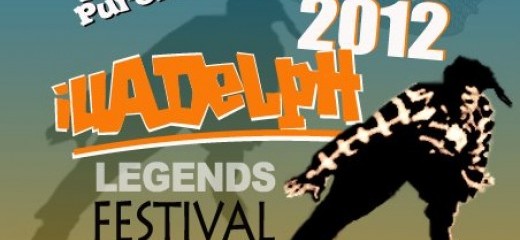
Photo: Rennie Harris Puremovement
My Profound Experience at Illadelph
My Profound Experience at Illadelph
On March 27, 2019, the author of this article requested a change to the title of this essay. The new title was published on April 5, 2019. No other alterations to this essay have been made.
After a mere five classes at the 2012 Illadelph Festival produced by Rennie Harris Puremovement (RHPM), I am in love with hip-hop. I am not entirely surprised. I have long admired hip-hop dancers I've seen perform in the city, and when I was enrolled at the University of the Arts, I even took a class with Harris, which was excruciating. In college I lived in a body that wore regulation black leotard and tights, that worked to get it “right,” that castigated itself for its own idiosyncrasies. Shifting from the kinesthetic principles practiced in ballet and Horton to hip-hop was difficult. I was quite sure I was embodying every stereotype out there about
white people trying to dance.
So it was after several post-college years of dancing in pieces where variation, improvisation, and personal expression are more important than getting the dancing “right” that I returned to hip-hop. I was curious how this body would respond to the classes.
I attended the workshop the day before the festival ended. The schedule included classes, jam sessions, and panel discussions, though I only attended technique classes. While most of the students were high-school aged and took the entire week of the workshop, individual classes were open to anyone who wanted to attend. Teachers included originators of styles, as well as younger dancers, achieving part of Illadelph's mission to preserve “the work of Hip-Hop's pioneers and support the creativity of the culture's next generation.” The festival took place in the studio at The Rock School on Broad Street, across the hall from the Rock's own summer intensive for younger dancers. As I signed in for the day, I expressed my trepidation to festival director Jeri Rayon. She assured me I would be fine as she led me past pictures of Rock students: toothy, smiling teenagers leaping through the air, their legs extended up to their ears, wearing costumes indicative of 19th-century Russian ballet.
I had arrived late, which was a subconscious attempt to avoid dancing in the first class. In ballet, if you are more than ten minutes late, you cannot participate. “Great!” my subconscious thought, “I'll just watch at first, take notes, and think hard.” But no. Jeri ushered me into the studio, instructed me to warm myself up and jump in when I was ready. From a downward-facing dog I saw something I rarely see in a dance studio: women and men of all ages, races, shapes, and sizes, dancing forcefully. A mere ten feet in front of RHPM principal dancer Crystal Frazier was an Asian boy who looked to be about twelve, the two throwing themselves into every shoulder roll and ball change. A few sun salutations later I jumped in and timidly began learning Mark “Smart Mark” Boston's choreography. I tried performing the steps with that sort of casual, hipster attitude that I sometimes employ to avoid looking like a jackass. Turns out, a surefire way to look like a jackass in this festival is to not dance with your entire body and soul.
The next class was House taught by Rennie Harris himself. Appropriately, we danced to house music, our rhythmic stepping and hopping reflecting the music's driving, hypnotic beat. To succeed in this style, you must keep moving. If you are off the beat, keep moving and you will get on beat. The proprioceptors in your joints will be able to pinpoint where your weight falls. Your pelvis is the source of movement from which your spine and legs extend, something that young dancers apparently forget. When none of us could hop across the studio in a low push-up, Harris bemoaned the fact that younger generations aren't as connected with their core. He criticized contemporary hip-hop for focusing on mimetic gestures that involve the arms but little of the axial skeleton. He reminded us that life originates in the pelvis, and if our dancing doesn't start there we may be missing out on a great deal of richness.
In Waacking with Tyrone Proctor, the title of the class refers to the movement of the arms around the head. Developed in gay clubs in the 70's in Los Angeles, this form looks similar to vogueing with many angular, sexual poses. With the flick of an arm or toss of the head, the musical emphasis shifts according to the dancer's preference: the beat embodied for a moment, and then the baseline, before sticking with the vocals. Proctor assigned vampy poses to the women to pepper in with improvised waacking, and prodded us to intimidate the men with our sexuality. When we failed, he sat us down and demonstrated to
Donna Summer. I defy you to watch
Proctor and not get chills. He unearthed musical subtleties that I couldn't hear, flinging an arm out a millisecond before the beat hit or luxuriously unfurling his fingers through several notes. As Donna moaned, he bit his index finger with a more feminine come-hither gaze than I could ever imagine executing. I tried again, pushing past the discomfort of feeling like
Britney Spears at the VMAs, past the voice in my head telling me that by hitting these poses I was somehow succumbing to the
commercialization of female sexuality. He stopped the teenage boys from enthusiastically performing the same poses, showing them several more “masculine” poses. I was surprised that the man who had, minutes before, pressed his pectoral muscles together to create cleavage would assign poses that reinforced traditional expressions of gender.
At the end of the day, Smart Mark came back and led us through another hip-hop phrase he had choreographed. In this style, mimetic gestures literally correspond with the lyrics, driven by the thick, aggressive rhythm. We undulated our spines as our fingers wrapped around imaginary triggers, stopping unexpectedly and picking up the beat in a new place in the music and our bodies. Mark choreographed the abrupt pauses as a direct critique to house dancing, where you can trick people into thinking you understand the music by not stopping. It was satisfying to pick up on a conversation between Mark and Rennie conveyed through their teaching styles.
But I'd like to return to the gestures, which often included pretending you were throwing money up in the air or holding different varieties of guns. Performing these gestures was uncomfortable. Did you know that on Urban Dictionary there is fierce debate about whether
“making it rain” refers to throwing money up in the air at a strip club or ejaculating on a woman's face? Yep. I have never held a gun, so when I pretended to, I remembered that hip-hop started in the economically devastated, non-white ghettos of the South Bronx in the seventies, a background much different than my own. I can't tell if the choreography was glamorizing the misogyny and race and class tension in hip-hop's culture, or honoring the realities of its origination and current expression. The playfulness with which Mark gave performative instructions eased that discomfort; I felt slightly less that my body was transgressing into forbidden cultural territory. As I left class, I wondered about that discomfort: even though my background and hip-hop's look different, they are far more intimately connected than my background and that of ballet, with its French and Italian aristocratic roots.
I returned the next day to Kyle Clark's House class. It was the perfect note on which to end my experience. Inspirational speeches punctuated his instructions and connected to what I had learned the day before about the basic principles of the Illadelph approach: Keep your weight low. Keep your knees bent. Self-consciousness is not an option. Getting the steps “right” is less important than fully expressing yourself. Anyone, anywhere, can do this. Clark even proclaimed hip-hop as a pedestrian dance. Hearing the word "pedestrian" in reference to such full-bodied movement was a shock. The
pedestrian dance familiar with is cool, reserved, the performers damping down their personality to perform. In his class I felt fully the basic principle of the Illadelph festival, and of RHPM as a company.
To dance connects you to a part of humanity that is deeper than race, gender, and class. If you let it, dance creates a space where issues that are both specifically American and global can be explored, critiqued: your assumptions can shift. Putting your body in sexy or violent positions it doesn't normally occupy allows you to engage in a kinesthetic empathy for the bodies that do hold guns or wear skimpy clothes every day. Seeing the same dance performed by a wide variety of bodies evokes a paradox: gender, race, and class disparities that lead to violence and oppression are real and ever-present, even if we are consciously or unconsciously ignoring them. But these realities are not permanent. They can shift, for better or worse.
I left my experience at Illadelph drenched in sweat, hoping for the day there is a building on Broad Street devoted entirely to teaching hip-hop, its walls covered in photos of the likes of Rennie Harris and Tyrone Proctor, where anyone can spend their entire summer, not just one week, trying this form on their bodies.
2012 Illadelph Legends Festival, The Rock School, www.rhpm.org/illadelph.php
By Annie Wilson
August 23, 2012









